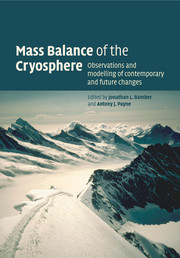Book contents
- Frontmatter
- Contents
- List of contributors
- Foreword
- Preface
- 1 Introduction and background
- Part I Observational techniques and methods
- 2 In situ measurement techniques: land ice
- 3 In situ measurement techniques: sea ice
- 4 Remote-sensing techniques
- Part II Modelling techniques and methods
- Part III The mass balance of sea ice
- Part IV The mass balance of the ice sheets
- Part V The mass balance of ice caps and glaciers
- Index
- References
2 - In situ measurement techniques: land ice
Published online by Cambridge University Press: 16 October 2009
- Frontmatter
- Contents
- List of contributors
- Foreword
- Preface
- 1 Introduction and background
- Part I Observational techniques and methods
- 2 In situ measurement techniques: land ice
- 3 In situ measurement techniques: sea ice
- 4 Remote-sensing techniques
- Part II Modelling techniques and methods
- Part III The mass balance of sea ice
- Part IV The mass balance of the ice sheets
- Part V The mass balance of ice caps and glaciers
- Index
- References
Summary
Introduction
Measurement of the mass balance of larger glaciers, ice sheets, ice caps and ice fields requires different field techniques than for the smaller valley glaciers. These larger glaciers are an integral part of the Earth's interactive ice–ocean–land–atmosphere system, and may also provide valuable insight into the cause of changes of the Earth's climate system (Meier, 1998).
In this chapter, we deal with in situ measurement techniques. However, we include measurements based on aerial photography, since such measurements for more than half a century have been used in combination with field studies. Modern, mainly satellite-based, remote-sensing techniques for measuring glacier mass balance are presented in Chapter 4.
Mass balance equations
In glacier context, the term ‘mass balance’ is traditionally used in two ways with different meanings. At a specific point of the glacier, the local mass balance designates the sum of accumulation (supply of mass mainly by snow deposition) and ablation (loss of mass mainly by melting of snow/ice). The local (specific) mass balance may be positive or negative depending on whether accumulation or ablation dominates. However, the sign of the specific mass balance does not say anything about the local change of ice thickness or the local change of mass in a vertical column through the glacier. This is because the specific mass balance may be compensated for, or even be overruled by, mass input/loss due to a gradient of the horizontal ice flux.
- Type
- Chapter
- Information
- Mass Balance of the CryosphereObservations and Modelling of Contemporary and Future Changes, pp. 11 - 42Publisher: Cambridge University PressPrint publication year: 2004
References
- 7
- Cited by



